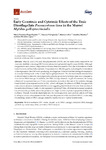Early Genotoxic and Cytotoxic Effects of the Toxic Dinoflagellate Prorocentrum lima in the Mussel Mytilus galloprovincialis

View/
Use this link to cite
http://hdl.handle.net/2183/19150Collections
- Investigación (FEDU) [938]
Metadata
Show full item recordTitle
Early Genotoxic and Cytotoxic Effects of the Toxic Dinoflagellate Prorocentrum lima in the Mussel Mytilus galloprovincialisAuthor(s)
Date
2016Citation
Toxins 2016, Vol. 8, Page 159
Abstract
Okadaic acid (OA) and dinophysistoxins (DTXs) are the main toxins responsible for diarrhetic shellfish poisoning (DSP) intoxications during harmful algal blooms (HABs). Although the genotoxic and cytotoxic responses to OA have been evaluated in vitro, the in vivo effects of these toxins have not yet been fully explored. The present work fills this gap by evaluating the in vivo effects of the exposure to the DSP-toxin-producing dinoflagellate Prorocentrum lima during the simulation of an early HAB episode in the mussel Mytilus galloprovincialis. The obtained results revealed that in vivo exposure to this toxic microalgae induced early genotoxicity in hemocytes, as a consequence of oxidative DNA damage. In addition, the DNA damage observed in gill cells seems to be mainly influenced by exposure time and P. lima concentration, similarly to the case of the oxidative damage found in hemocytes exposed in vitro to OA. In both cell types, the absence of DNA damage at low toxin concentrations is consistent with the notion suggesting that this level of toxicity does not disturb the antioxidant balance. Lastly, in vivo exposure to growing P. lima cell densities increased apoptosis but not necrosis, probably due to the presence of a high number of protein apoptosis inhibitors in molluscs. Overall, this work sheds light into the in vivo genotoxic and cytotoxic effects of P. lima. In doing so, it also demonstrates for the first time the potential of the modified (OGG1) comet assay for assessing oxidative DNA damage caused by marine toxins in marine invertebrates.
Keywords
Bivalve molluscs
DSP toxins
Okadaic acid
Dna damage
Oxidative dna damage
Cytotoxicity
Comet assay
Flow cytometry
Ogg1 enzyme
DSP toxins
Okadaic acid
Dna damage
Oxidative dna damage
Cytotoxicity
Comet assay
Flow cytometry
Ogg1 enzyme
Editor version
Rights
Reconocimiento 3.0
ISSN
2072-6651






